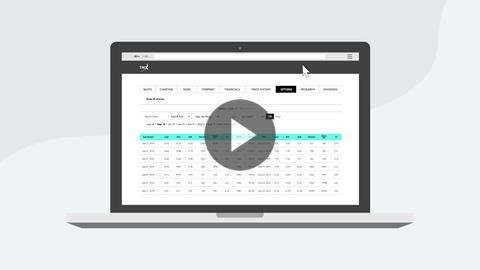Level Up Your Options Knowledge and Skills with Options-Ed
Welcome to Options-Ed, your online options education hub! Our goal is to provide valuable resources and guidance for investors of all levels. So, whether you're just starting out or are an experienced investor looking to expand your knowledge, you've come to the right place. We’re here to help you navigate the complexities of the Canadian options market with ease.
Our user-friendly hub is designed to empower you with a wealth of easy-to-understand information and skills to help you confidently unlock the full potential of options trading and maximize your investment opportunities.
So, grab a cup of coffee, sit back, and dive into the exciting world of options trading and start building your path to financial success!
Covered Call Screener
Your fast track to ideal options! Conservative investors, find options matching your yield and gain goals in a snap. Your perfect investment awaits!
Options Calculator
Supercharge your options strategy with our smart calculator! Spot bargains, predict profits, and master Greeks instantly for stocks and ETFs. Synced with our data for easy use, this tool is your shortcut to smarter trading.
TMX Trading Simulator
Our trading simulator lets you test any strategy and watch your trades unfold in real-time. Experiment, learn, and fine-tune your skills – all without risking a dime.
Glossary
Need clarity on a specific financial or trading term? Consult our Derivatives Glossary.
Options Trading Courses for Beginners
New to options trading? Our comprehensive series of options trading courses are designed just for you.
We break down complex concepts into easy-to-understand lessons. Whether you're just starting out or have some experience with financial products, our step-by-step guide will help you grasp the basics of options trading.
Learn the basics, understand the risks, and gain confidence to start trading - all at your own pace.

Introduction to Options
Discover what options are, their benefits and risks, and how they differ from stocks in this beginner-friendly guide.

Basic Options Terminology
Master essential options trading terms. Explore key concepts like strike price, expiration date, and premium to build a strong foundation in options investing.

Call Options Explained
Dive into the world of call options. Learn what call options are, when to use them, and how they can potentially boost your investment returns.
Options Trading: Watch and Learn Series
Dive into our free animated video series from the Montréal Exchange and Canadian Derivatives Institute! Perfect for beginners, these bite-sized lessons demystify options lingo, explain calls and puts, and even teach you how to read option chains. From basics to pro tips, we've got you covered. Pair these videos with our Options Trading Courses and options-focused articles for a complete learning experience. No experience? No problem! Just click to watch and level up your trading game!

What are the benefits of using options?
Discover how options can amplify your trading strategy. From hedging risks to generating income, these versatile tools offer more opportunities than you might think. Ready to expand your financial toolkit?

What exactly are options?
These financial tools give investors the right to buy or sell stocks at a set price by a specific date. Discover how options can potentially enhance your portfolio or manage risk.

How to read Option Quotations?
Want to trade options? Start by mastering option quotations. These crucial snapshots reveal an option's trading price and market value. Think of them as your trading roadmap – essential for navigating the options market confidently.
Find a Broker
Looking for an online or full service Canadian broker to help you invest?
VIEW OUR LIST OF PARTICIPANTS
